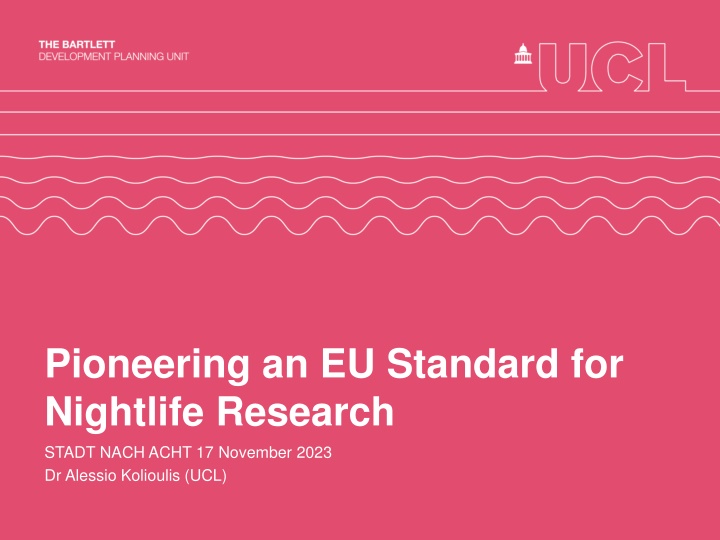
Exploring Industry Standards and Nightlife Research Initiatives
Discover the classification systems of economic activities through industry standards like ANZSIC, ISIC, NACE, and NAICS. Learn about the GLA methodology for identifying industries related to night-time cultural and leisure activities and delve into pioneering an EU standard for nightlife research. Explore the diverse sectors of agriculture, manufacturing, accommodation, and more within the framework of industry classifications and research endeavors.
Download Presentation

Please find below an Image/Link to download the presentation.
The content on the website is provided AS IS for your information and personal use only. It may not be sold, licensed, or shared on other websites without obtaining consent from the author. If you encounter any issues during the download, it is possible that the publisher has removed the file from their server.
You are allowed to download the files provided on this website for personal or commercial use, subject to the condition that they are used lawfully. All files are the property of their respective owners.
The content on the website is provided AS IS for your information and personal use only. It may not be sold, licensed, or shared on other websites without obtaining consent from the author.
E N D
Presentation Transcript
Pioneering an EU Standard for Nightlife Research STADT NACH ACHT 17 November 2023 Dr Alessio Kolioulis (UCL)
Industry Standards are a classification system of economic activities CODE A B C D E SECTION DESCRIPTION Agriculture, Forestry and Fishing Mining and Quarrying Manufacturing Electricity, Gas, Steam and Air Conditioning Supply Water Supply; Sewerage, Waste Management and Remediation Activities Construction Wholesale and Retail Trade; Repair of Motor Vehicles and Motorcycles F G Transportation and Storage Accommodation and Food Service Activities Information and Communication Financial and Insurance Activities Real Estate Activities Professional, Scientific and Technical Activities Administrative and Support Service Activities Public Administration and Defence; Compulsory Social Security Education Human Health and Social Work Activities Arts, Entertainment and Recreation Other Service Activities Activities of Households as Employers; Undifferentiated Goods- and Services-Producing Activities of Households for Own Use Activities of Extraterritorial Organizations and Bodies H I J K L M N O P Q R S T U NACE, Eurostat 2023 2
Industry standards 1. The Australian and New Zealand Standard Industrial Classification ANZSIC 2. United Nations International Standard Industrial Classifications ISIC 3. Statistical Classification of Economic Activities in the European Community since 2008 NACE 4. The North American Industry Classification System (Canada, Mexico, and the United States of America) - NAICS 5. United Kingdom Standard Industrial Classification of Economic Activities UKSIC While most systems are harmonised at the first hierarchical level, they differ in the number of hierarchical levels and codes within each classification 3
Greater London Authority (GLA) methodology for identifying industries based on labour force survey Night-time cultural and leisure activities Activities which support night-time cultural and leisure activities Retail sale in non-specialised stores (SIC07: 471) Retail sale of food; beverages and tobacco in specialised stores (SIC07: 472) 24-hour health and personal social services 24-hour health and personal social services Hotels and similar accommodation (SIC07: 551) Restaurants and mobile food service activities (SIC07: 561) Event catering and other food service activities (SIC07: 562) Provision of services to the community as a whole (SIC07: 842) Hospital activities (SIC07: 861) Other human health activities (SIC07: 869) Animal production (SIC07: 014) Mixed farming (SIC07: 015) Support activities to agriculture and post-harvest crop activities (SIC07: 016)
Proportion of all workers in the UK by SIC section and time of day usually worked (ONS, 2023) 5
Labour Force Survey The Labour Force Survey uses variables USUWRK1 (day), USUWRK2 (evening), and USUWRK3 (night) to define respondents' usual work patterns. This classification is crucial for determining night-timeworkers and industries. The question is voluntary and is asked annually in Q2 (April to June), not accounting for daylight savings or seasonal changes. There are no fixed definitions of what constitutes the day, the evening or the night, and respondents interpret which apply to them. Title of presentation 6
Broader challenges Data collection is resource-intensive, necessitating advocacy for more regular, detailed datasets. While national-level data is often available, city-specific data is less common, leading to a gap in strategic planning at the city level where policies are implemented. Qualitative research is essential for uncovering no name issues that are not easily quantified or lack clear categorization. Standardizing temporal definitions for activities (e.g., night-time hours) is crucial, as they can differ by location, such as London s 6 PM-6 AM or definition on darkness, reflecting seasonal variations 7
Opportunities 1. EU research projects under HORIZON EUROPE 2. The New European Bauhaus 3. The 100 Climate- Neutral and Smart Cities by 2030 8






















